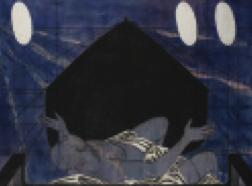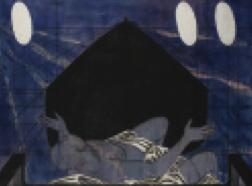Ismael Frigerio
Patricia Ready. Santiago de Chile
Ismael Frigerio (1955) emerged at the end of the 1970s from a generation of Chilean painters influenced by the transavantgard and Neo-Expressionism. He emigrated to New York, and back in his country at the beginning of the 1990s he produced work that went beyond avowed hedonism and an autobiographic tone.

With versatility, moving across painting, video and installation, he also nourished his production with references to literature, philosophy and a critical gaze on present day society nuanced by an existentialist tone, without ever ceasing to refer to painting and its history. “Sombras de la modernidad” (Shadows of Modernity) is comprised of fourteen large format canvases tending towards monochromy, tensioning the graphic and the pictorial. In red, blue or yellow tones, on washes or layers of pigment, the line draws vanishing points, faraway horizons and rigorous compositions featuring bodies, spread out bed sheets, ships small sailboats, houses or beds and maps, nautical charts or road layouts. It includes three series: “La Nave de los locos” (The Madmen’s Ship), “El continente” (The Continent) and “El desnudo en la historia del arte” (The Theme of Nude in Art History). Subjects that he has always found disquieting navigate along these fragmentary images of an archetypal character: the journey, madness and death. They involve, above all, the presence of the human body in terms of geographic anatomy unraveling itself barely as a sketch, a trace, an icon that captures the gaze. Beside a wall, the only object outside the painting rests under the monumental projection of a close-up of the water. There is no possible horizon, only the motionless boat, the calm sea, and the silence of the end of the journey.




